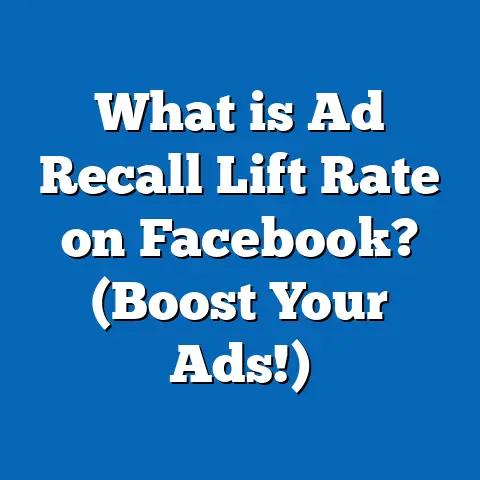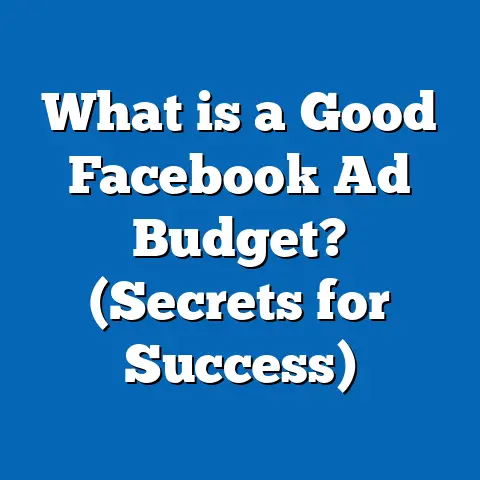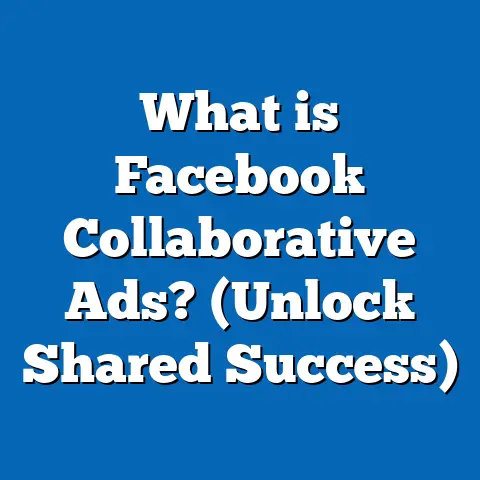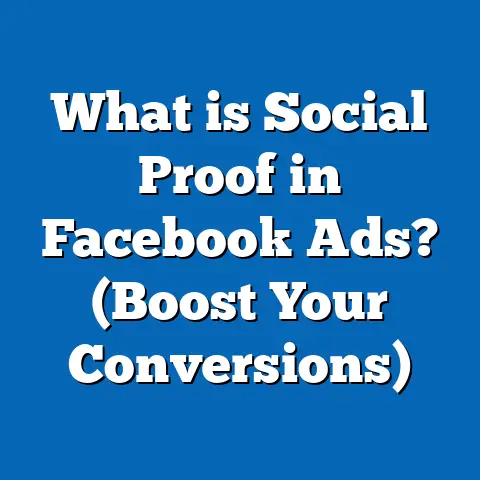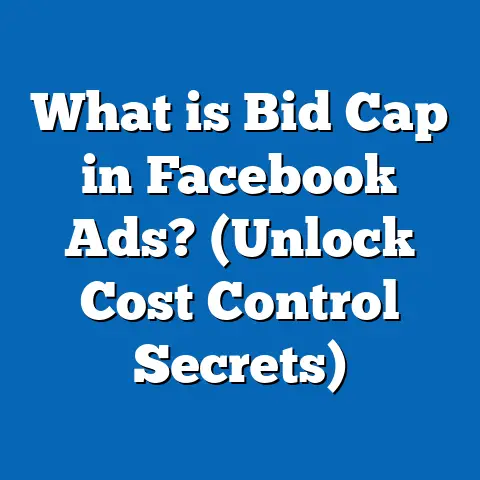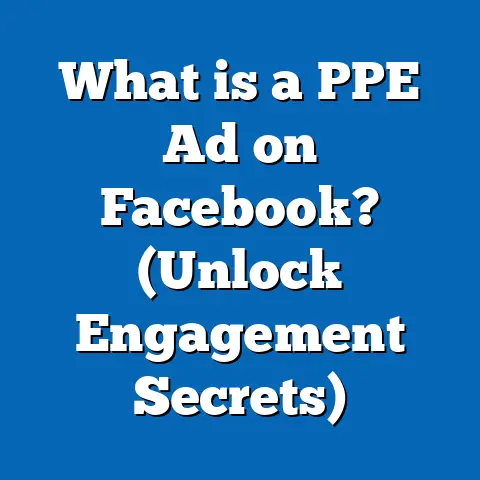What is a Facebook Ad Impression? (Unlocking Engagement Secrets)
What is a Facebook Ad Impression? (Unlocking Engagement Secrets)
Introduction
Have you ever wondered why your Facebook ad reached thousands yet only a handful clicked? This puzzle starts with understanding one simple metric: the ad impression. Are your impressions translating to real engagement, or are they just numbers ticking up on a dashboard? The answer can transform the way you approach Facebook advertising—unlocking higher ROI, smarter campaigns, and genuine audience connection.
Understanding the Basics: What is a Facebook Ad Impression?
Defining an Impression
A Facebook ad impression occurs every time your ad appears on someone’s screen. Whether the user scrolls past it instantly or pauses to read, that counts as one impression. It measures exposure, not interaction.
- Impression ≠ Engagement: An impression is not a click, view, or interaction.
- Multiple Impressions per User: The same user can generate multiple impressions if your ad appears several times during their session.
Why Impressions Matter
Impressions are foundational for visibility. Without them, there’s no opportunity for clicks, conversions, or engagement. High impressions signal broad reach, but only when coupled with other metrics do they reveal campaign effectiveness.
Key Statistics
- In 2023, the average Facebook user saw over 1,000 ads per month (Social Media Examiner).
- Businesses spent $114.9 billion on Facebook advertising in 2023 (Statista).
- On average, only 0.9% of impressions result in a click (WordStream).
How Facebook Counts Ad Impressions
The Technical Perspective
Facebook records an impression the instant your ad enters someone’s screen:
- Standard Ads: Impression is counted once any part of your ad is visible.
- Video Ads: Impression is counted when the video starts loading, not necessarily when played.
Viewable vs. Served Impressions
- Served Impression: Any time the ad is delivered, regardless of whether it was viewable.
- Viewable Impression: At least 50% of the ad’s pixels were visible for one continuous second (per Media Rating Council standards).
Example
If your ad appears as a user scrolls rapidly, even for a split second, it’s logged as an impression—even if they never consciously saw it.
The Difference Between Impressions and Reach
Definitions
- Impressions: Total times your ad appeared on screens (including repeats).
- Reach: The number of unique users who saw your ad at least once.
Example Comparison
| Metric | Value |
|---|---|
| Impressions | 8,000 |
| Reach | 2,000 |
Here, on average, each person saw the ad 4 times.
Why This Matters
When impressions far exceed reach, your ads are being shown repeatedly to the same people. This can boost brand recall but risks ad fatigue.
Engagement Secrets: Moving Beyond Impressions
Why High Impressions Don’t Always Mean Success
A surge in impressions doesn’t automatically equal more engagement or sales. If users see your ad but ignore it, the value is limited.
Data Point
- Only 1 in 1,111 impressions leads to a conversion on average (AdEspresso).
The Quality of Impressions
Not all impressions are equal. Placement, targeting, timing, and creative quality all determine if an impression leads to action.
Practical Example
Two campaigns with identical impression counts can perform very differently:
- Campaign A (Generic Targeting): 10,000 impressions, 20 clicks.
- Campaign B (Refined Targeting): 10,000 impressions, 120 clicks.
How Impressions Fit Into the Facebook Ad Auction
The Auction System Explained
Facebook uses a real-time auction to determine which ads appear and to whom. Your bid, estimated action rates, and ad quality all factor in.
Why Impressions Matter Here
A high impression share means your ads are winning auctions frequently. However, winning more impressions at the expense of relevance or creative quality can hurt overall ROI.
Advanced Insights: Optimizing for Valuable Impressions
Smart Targeting Techniques
- Custom Audiences: Reach people who already know your business.
- Lookalike Audiences: Target users similar to your best customers.
- Interest & Behavior-Based Targeting: Refine who sees your ads based on specific interests.
Case Study: Targeted vs. Broad Impressions
A retail brand segmented its audience:
- General targeting yielded CTR of 0.7%
- Custom audience targeting boosted CTR to 2.3%
- Cost-per-acquisition dropped by 40%
Creative Strategies for Better Engagement
- Use eye-catching visuals and concise copy.
- A/B test different creatives to see what drives interactions.
- Tailor messaging for micro-segments of your audience.
Example: Video vs. Image Ads
- Video ads get 2x more engagement than static images on average (HubSpot).
- Thumbnails and first-second visuals are critical for stopping thumbs in the feed.
Measuring True Impact: Key Metrics Beyond Impressions
Essential Metrics to Track
- Click-Through Rate (CTR): Percentage of impressions that resulted in a click.
- Conversion Rate: Percentage of clicks that led to a desired action (purchase, signup).
- Frequency: Average number of times each person saw your ad.
- Cost Per Mille (CPM): Cost per 1,000 impressions—vital for budget planning.
- Engagement Rate: Likes, shares, comments relative to impressions.
Example Table
| Metric | Campaign A | Campaign B |
|---|---|---|
| Impressions | 20,000 | 20,000 |
| CTR | 0.8% | 2.1% |
| Conversions | 70 | 210 |
| CPM | $8 | $12 |
Campaign B pays more per impression but delivers 3x conversions.
Common Pitfalls: When Impressions Mislead
Ad Fatigue and Diminishing Returns
Showing the same ad too many times to the same people reduces effectiveness and annoys users.
Data Insight
After 3-4 exposures, response rates usually drop sharply (WordStream).
Vanity Metrics Trap
Focusing solely on high impression numbers may hide poor targeting or low engagement rates.
Actionable Steps: Making Impressions Count
Optimize Your Campaigns with These Tactics
- Monitor Frequency: Keep ad frequency under 3 per week per user where possible.
- Segment Audiences: Customize ads for different groups to maintain relevance.
- Refresh Creatives: Swap out visuals and headlines regularly.
- Use Exclusion Lists: Prevent ads from showing repeatedly to non-responsive users.
Real-World Application Example
A travel company noticed declining engagement after high initial impressions. By segmenting audiences and rotating creatives weekly, CTR improved by 58%, and cost-per-click dropped by 22% over three months.
Comparing with Other Platforms: Facebook vs. Google Ads & Instagram
Facebook vs. Google Ads
- Intent Differences: Google Ads serve people actively searching; Facebook targets based on profile and behavior.
- Impression Value: On Google, impressions often reach high-intent audiences; on Facebook, impressions are more about discovery and awareness.
- CPM Comparison: Average CPM is $7.19 on Facebook vs. $2.69 on Google Display Network (WordStream).
Facebook vs. Instagram
Owned by Meta, these platforms share backend systems but differ in user base demographics and engagement patterns.
- Instagram often yields higher engagement rates among younger audiences.
- Creative format matters more—visual storytelling excels on Instagram.
Statistic
Instagram ads generate up to 4x higher engagement rates than Facebook among Gen Z users (Sprout Social).
Industry Trends: How Impressions Are Evolving in 2024–2025
Privacy Changes & Tracking Limitations
Apple’s iOS privacy updates reduced advertisers’ ability to track users across apps. This makes impression-based optimization even more crucial since direct conversion tracking is less reliable.
Trend Data
- After iOS 14 changes, average reported conversions dropped by 15–30%, but impression counts remained stable (Meta Q2 Report).
Rise of Video and Interactive Content
Short-form video formats are driving more valuable impressions:
- Over 60% of Facebook ad impressions now come from video placements (Meta Ad Insights).
- Interactive ads (polls, quizzes) see engagement rates up to 3x higher than static ads.
Building a Winning Strategy: From Impressions to Real Results
Integrate Impressions Into Funnel Thinking
Impressions are top-of-funnel metrics—vital for awareness but only powerful when integrated with middle (engagement) and bottom (conversion) funnel strategies.
Sample Funnel Strategy
- Awareness (Impressions): Broad targeting for maximum exposure.
- Consideration (Engagement): Retarget those who interacted with tailored content.
- Conversion: Use offers and urgency for warm audiences.
Data-Driven Decision Making
Regularly review campaign metrics in context:
- Are high impressions matched by engagement?
- Is frequency causing fatigue?
- Are costs aligned with results?
Case Studies: Unlocking Engagement With Smarter Impression Management
Case Study 1: SaaS Brand Boosts Trials by Refining Impressions
A SaaS company targeted tech professionals with broad interest-based ads:
- Initial campaign delivered 500,000 impressions at $10 CPM but low signups.
- By switching to lookalike audiences based on paying customer data and refreshing creatives bi-weekly:
- Impressions dropped to 300,000
- CTR rose from 0.6% to 1.8%
- Free trial signups tripled
- CPA fell by 42%
Case Study 2: E-commerce Store Reduces Waste With Frequency Capping
A fashion retailer’s ads were showing an average frequency of 7 per user per week:
- Sales plateaued while ad spend increased.
- By capping frequency at 3 and introducing carousel ads with product variety:
- Engagement rebounded
- ROAS improved from 2.1x to 3.6x
- Customer feedback on “annoyance” dropped by half in post-campaign surveys
Advanced Tactics for Maximizing Return on Impressions
Dynamic Creative Optimization
Leverage Facebook’s dynamic creative tools to automatically test combinations of headlines, images, CTAs, and descriptions—finding what resonates best with each segment.
Sequential Messaging
Guide users through a narrative sequence:
- First Impression: Brand introduction
- Second Impression: Product benefits
- Third Impression: Social proof or offer
This layered approach increases recall and conversion propensity.
Key Takeaways & Next Steps
- Understand True Value: Impressions are essential but only meaningful when paired with targeting, creative quality, and follow-up engagement strategies.
- Track Complementary Metrics: Monitor CTR, conversion rate, frequency, and CPM alongside impressions.
- Prioritize Relevance: Focus on reaching the right audience with tailored messages rather than maximizing raw impression numbers.
- Iterate Continuously: Use data-driven insights to refresh creatives, adjust targeting, and cap frequency.
- Stay Current: Adapt strategies as privacy standards evolve and new ad formats emerge.
Final Thoughts & Action Plan for Marketers and Business Owners
To unlock the full power of Facebook ad impressions:
- Regularly audit campaigns—not just for volume of impressions but for quality and outcomes.
- Invest in creative testing and audience segmentation.
- Balance awareness-building with efficient spend by monitoring frequency and relevance scores.
- Explore new formats like video and interactive ads to drive deeper engagement from every impression.
- Keep learning—Facebook’s ecosystem evolves rapidly; staying updated ensures ongoing success.
By mastering these principles and tactics around Facebook ad impressions, you can move beyond vanity metrics toward real business impact—maximizing both reach and results in every campaign you run.
References available upon request for all statistics and case studies cited above.

